These Yogic Kriyas are the purification processes of the body by yogic methods. They are very important in yoga. Union of body with mind, union of mind with soul and union of soul with God is Yoga.
Kriyas are to be practised early in the morning on empty stomach. Kriyas must be finished before starting the Asanas or Pranayama.
These Kriyas consist of six purification practises :
Dhauti (Kunjal)
Tratak
Basti
Nauli
Neti
Kapalbhati
Dhauti (Kunjal)
It means wash your stomach by water.
Two or three litre of tepid water is required. Squat on your feet back, spine and neck should be straight. Drink glasses of tepid water continuously without any pause upto the brim of neck.
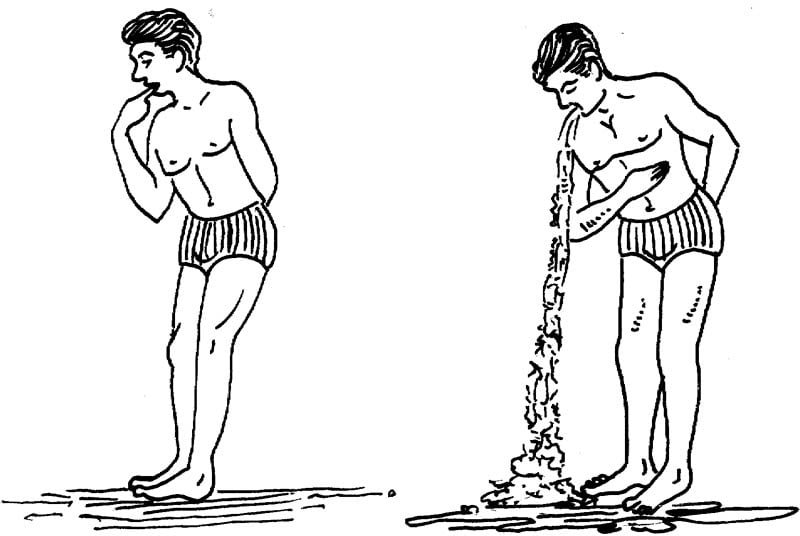
One should neither talk nor laugh during this period. He should not bend and should stand.
Bend a bit forward. Keep the left hand on the left knee and the first and second finger of the right hand in your throat. Press the stomach by the other hand. You will vomit. Vomit the whole drunk water. Water should not remain in stomach.
Wash you hands and take rest. Milk or breakfast should be taken after an hour.
This Dhauti kriya should be practised after passing stool and after bath. One should not take bath after this kriya. Vaman Dhauti kriya should be practised once a fortnight or once a month.
Precautions : 1. Heart patients should not practise it. 2. The nails of the fingers should be trimmed otherwise they may wound the throat.
Benefits : 1. Disorders of bile and gas are cured. 2. It is beneficial in the diseases of stomach throat and jaundice.
Basti (Enema)
Enema pot, rubber tube, nozzle, tepid water, lemon are the requirements. Mix juice of one or two lemons in the tepid water. Fill the enema pot with water.
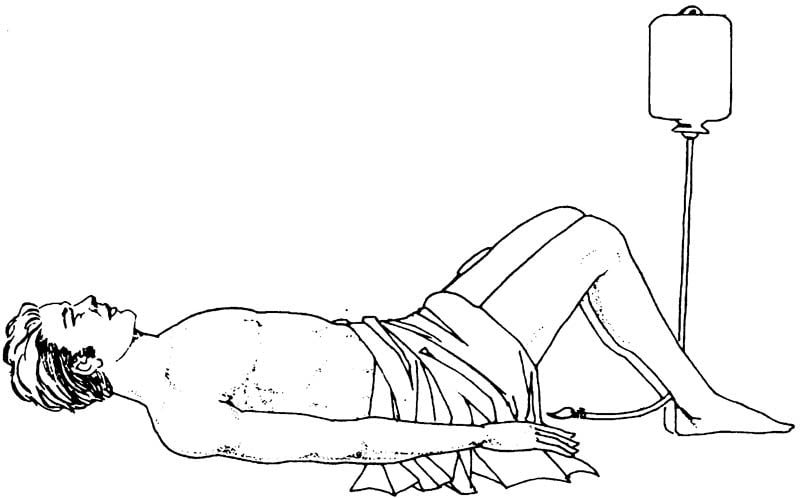
Suspend the enema pot one metre above. Apply a little oil or vaseline to the nozzle of the rectal tube. Before insertion, check the rectal tube to ensure free flow of water. Insert the tube into the rectum. The flow of water can be adjusted with the knob attached to the tube. When all the water has been introduced, remove the tube and resist the pressure for a few minutes. The bowels can be emptied after a while for better cleansing. If one does not wish to take enema in the lying position you can take it in the standing position.
Special Note : Enema should be taken after going to toilet. Salt can be mixed in water instead of lemon juice. You can use plain water also. Soap should not be mixed in water.
Precautions :
1. Enema should be taken once in a week or in a month by a healthy person.
2. It can be taken for two to four times daily in constipation.
3. Take rest for half an hour after enema.
4. Do not take any thing after enema for an hour.
Benefits :
1. Removes constipation.
2. Cleans bowels.
3. Beneficial in all diseases of stomach.
Neti
It is mainly of two types : 1. Jala Neti 2. Sutra Neti.
Jala Neti
For doing this, squat on your feet. Take tepid salted water in a medium sized pot with a long spout, made especially for this purpose.
Now fill the pot with tepid salted water and hold it in your right hand to the level of your nose. Then tilt your head slightly to the left so as to have the slanting position of the left nostril. Insert the nozzle of the spout into the right nostril and allow the water to flow down slowly. The water should continue falling down from other
nostril in a continuous thin stream. Now repeat the process from the other side. Breath through the mouth only till the kriya is complete. After Jal Neti, stand erect with your feet together. Keep the hands behind your back clasped and blow out vigorously whatever trace of water that has remained in your nostrils.
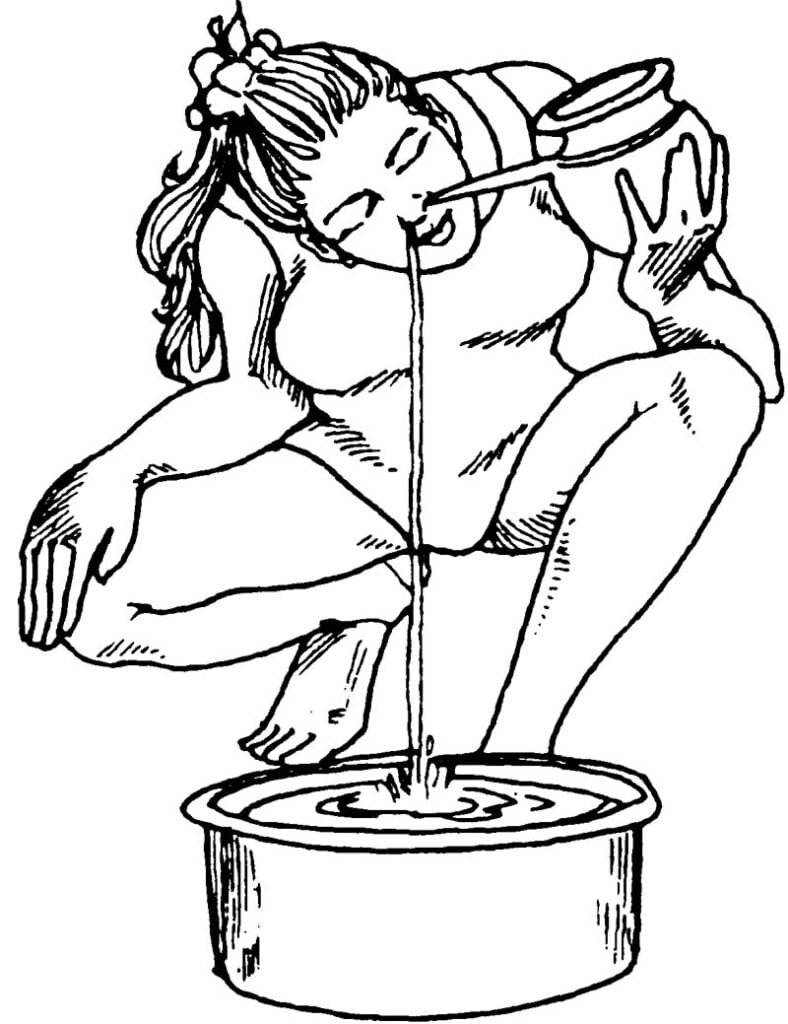
Precautions : If sometimes one feels intolerable pain in the back of ear or above nostrils, he should practise the Kriya of Kapalbhati at once. It will cure the pain.
Water can come out of eyes in beginning of Neti. Do not fear.
Benefits:
1. It cures sinusitis and clears sinuses.
2. It cures diseases of nose, eyes, throat and prevents the occurrence of diseases.
3. It purifies mind.
4. It improves memory.
5. It cures coryza and removes old accumulated phlegm.
Sutra Neti or Rubber Neti
Sutra Neti is performed with a 12 inches long piece of waxed cord. It is partly twisted and it makes the nasal insertion possible.
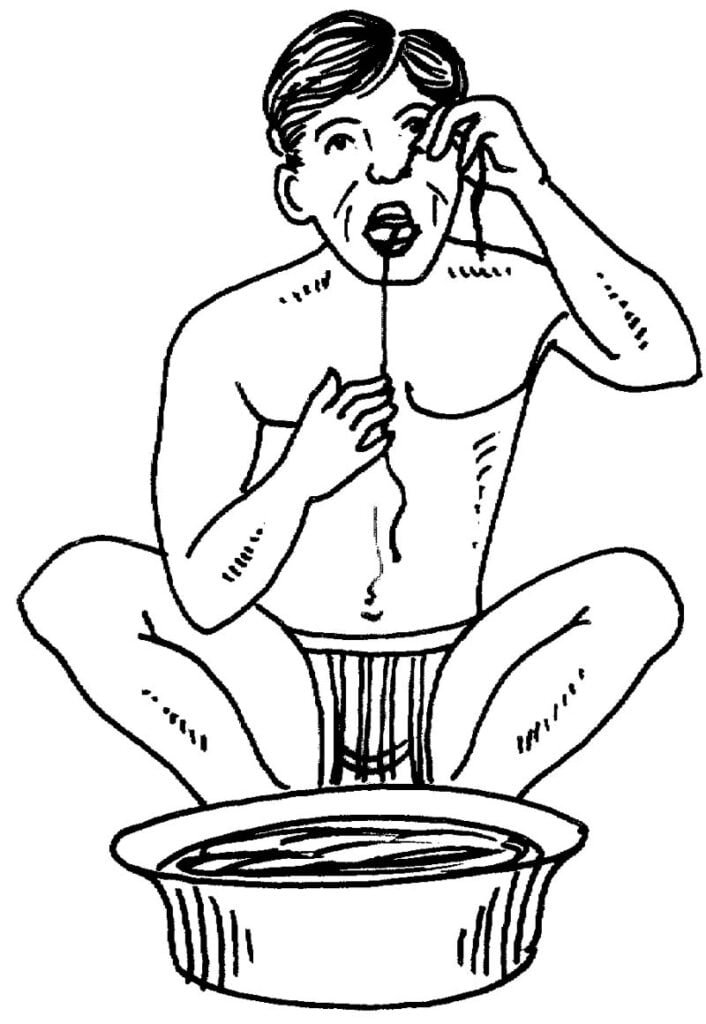
Squat on your feet. Take tepid salted water and soak the Neti well in it. Now take the waxed and twisted end of the cord and make it to curve. Bend your head slightly forward and insert the end of the cord into the nostril through which you have been breathing at that time. Push the cord gradually through the nose, down the throat. Now open your mouth wide, put your index and middle fingers in and with their tips catch the inside end of the cord and draw it out. Hold both the ends in your hand separately and pull the cord very gently up and down three to four times. Then take it out, wash it and then repeat the cycle with the other nostril.
After completion of the kriya, wash the cord with soap well and leave it to dry in some cleanand safe place so that the flies, etc. do not pollute it.
Special note :
1. When the cord reaches throat through nostrils, it becomes greasy by mucus. Therefore, both the ends of the cord should be caught firmly.
2. Sutra Neti or Rubber Neti should be practised after learning Jal Neti. After this one can practise Neti with milk, oil or ghee.
3. It is more beneficial to perform this Sutra Neti by cotton cord but it should be wrapped.
Precautions :
1. One can sneeze in practising Sutra Neti. Water can come out of eyes. One should not fear. Practise makes one perfect.
2. Nose can bleed sometimes while performing Sutra Neti. In such conditions use rubber catheter (No. 4) instead of cotton cord. Move the cord through nostrils and throat slowly and gently.
Benefits :
1. It cures all diseases of nose. 2. It reduces polyp in nose. 3. It cures sinusitis. 4. It cures coryza. 5. It improves eyesight. 6. It improves memory. 7. It purifies mind.
Nasapan
Drinking water through nostrils is called Nasapan. One should clean the nostrils before drinking water through them.
Milk Neti
Milk is used in place of water. Milk should be without malai or cream.
Benefits : Nasapan prevents cold and coryza. It improves eyesight.
Oil Neti
Mustard oil should be made warm in a spoon. When it is lukewarm and tolerable to the skin, lie down on a bed and drip five or seven drops of oil through some dropper in both the nostrils and try to draw them in. You will feel that the oil going in. You can use clean cotton instead of dropper. Coconut or almond oil can be used in place of mustard. Pure ghee can also be used. Three or four drops of ghee or Badam Rogan are sufficient for the nostrils.
Oil Neti or Neti of ghee should be done before going to bed at night.
Benefits : It lubricates noses and cleanses it. It prevents from cold and coryza.
Tratak
It is an amazing exercise to improve your power of concentration and eyesight.
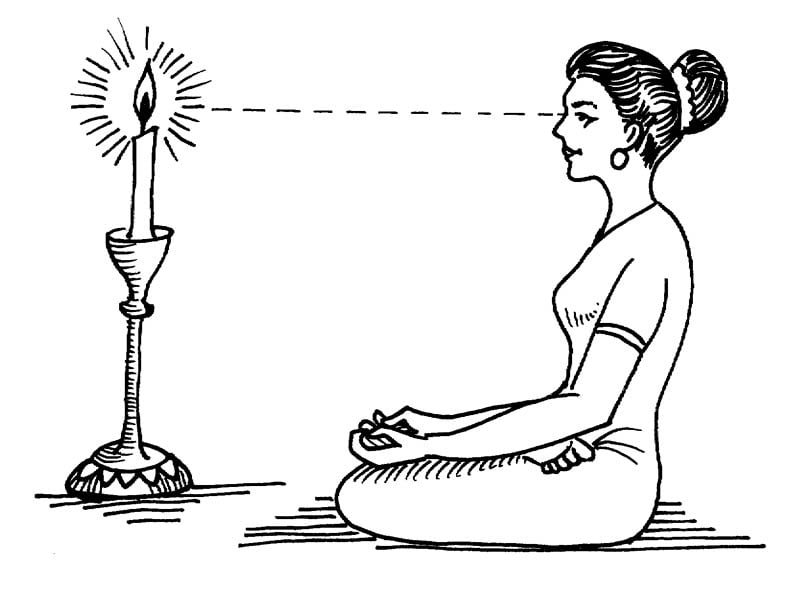
It can be practised with a candle or with a black dot on a piece of paper fixed on the wall. Start this practice in a closed room, as there will be less objects to disturb your concentration.
Sit on floor in any comfortable or Padmasana pose. Keep your back and spinal cord erect. Have a few deep breaths. Make your breath steady, even and rhythmic. Keep the object of your gaze at your eye level at a distance of three to four feet. Keep the eyes meditatively wide out of your eyes. Close the eyes to let tears trickle down.
Now mentally visualize that object, when the mental image visualizes, open your eyes and start gazing afresh. Do not strain your nerves and get relaxed. Let not your mind wander. Try to bring your mind back to the object but without straining yourself much as that would sap your energy and you will be tired soon.
After practising with the point on the walls or on a steady flame, try to do it concentrating on the tip of your nose on the point between the eyebrows.
Benefits :
1. It improves eyesight and removes the diseases of eyes.
2. It helps in concentrating your mind.
3. It purifies your mind.
Nauli Kriya
It is the best exercise for preserving and promoting the health of abdominal viscera.
Nauli should be practised daily in the morning on empty stomach and evacuated bowels.
Stand with legs one foot apart. Bend the legs a little and stoop forward. Rest the palms on thighs just above your knees, with fingers spread. Press the thighs well with your palms and the chest with your chin at the notch between the collar bones.
Inhale deeply and exhale vigorously so as to force out all the air from the lungs.
Suspend the breath and pull the abdominal region back towards the spine so that a hollow is formed.
Push the abdominal recti forward so that a vertical ridge down the centre is formed. Remain in this position for a few seconds and then relax the gap and inhale smoothly.
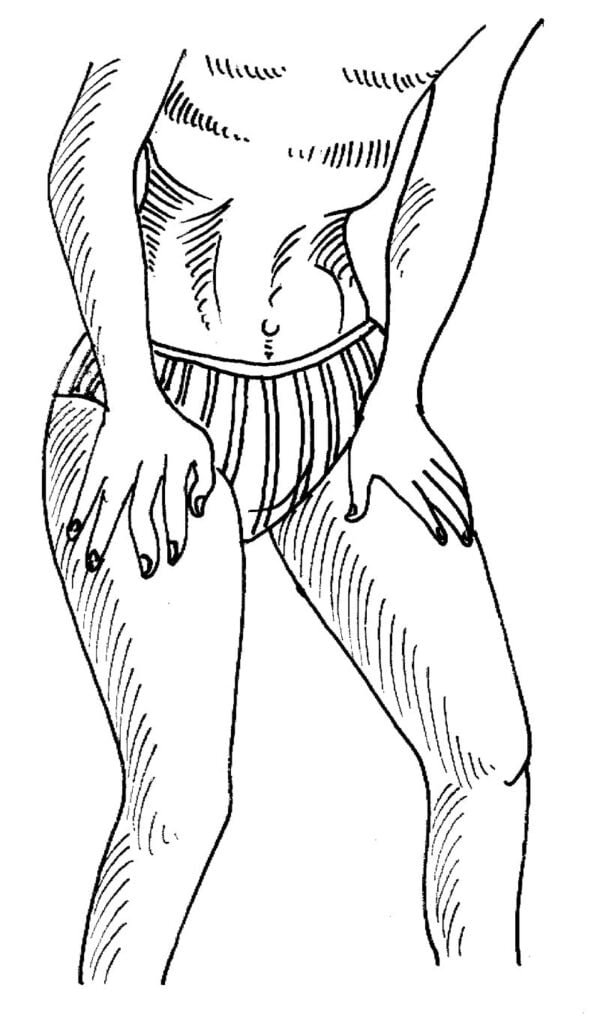
Breath deeply three to four times and then repeat the cycle. Repeat it five to seven times.
Special note :
1. Nauli kriya is not easy. Obese persons feel difficulty in its practise. It is essential to practice Uddiyana Bandha and Agnisar to perform Nauli.
2. Nauli kriya should be performed on empty stomach after cleaning bowels and before taking food.
3. One should wear only underwear while practising Nauli. Women can wear bra/ brassiere also.
Precautions :
1. Nauli should be practised on empty stomach.
2. It should not be practised unless there is some expert to demonstrate and then to guide and supervise the whole process.
3. It should not be practised before the age of 12 or 13 years.
4. The ulcer patient and the weak person should perform Nauli on the advice of Yoga therapist.
5. The patients suffering from swelling of intestines, dysentery, hernia and high blood pressure should not practice Nauli.
Benefits : The benefits of Nauli are many. It strengthens the abdominal muscles and liver. Women who suffer from menstrual problem get immediate relief. It increases gastric fire and helps eliminating the toxic elements from the digestive system. It also helps in ovarian insufficiency. Nauli quickly cures constipation, dyspepsia, flatulence etc.
Kapalbhati
Kapal means skull and Bhati means shine or lustre. Thus, this term means ‘skull shining’. Kapalbhati is a Pranayama also besides one of the six cleaning exercises. Actually this kriya or cleansing process is a milder form of Bhastrika, another vigorously breathing exercise.
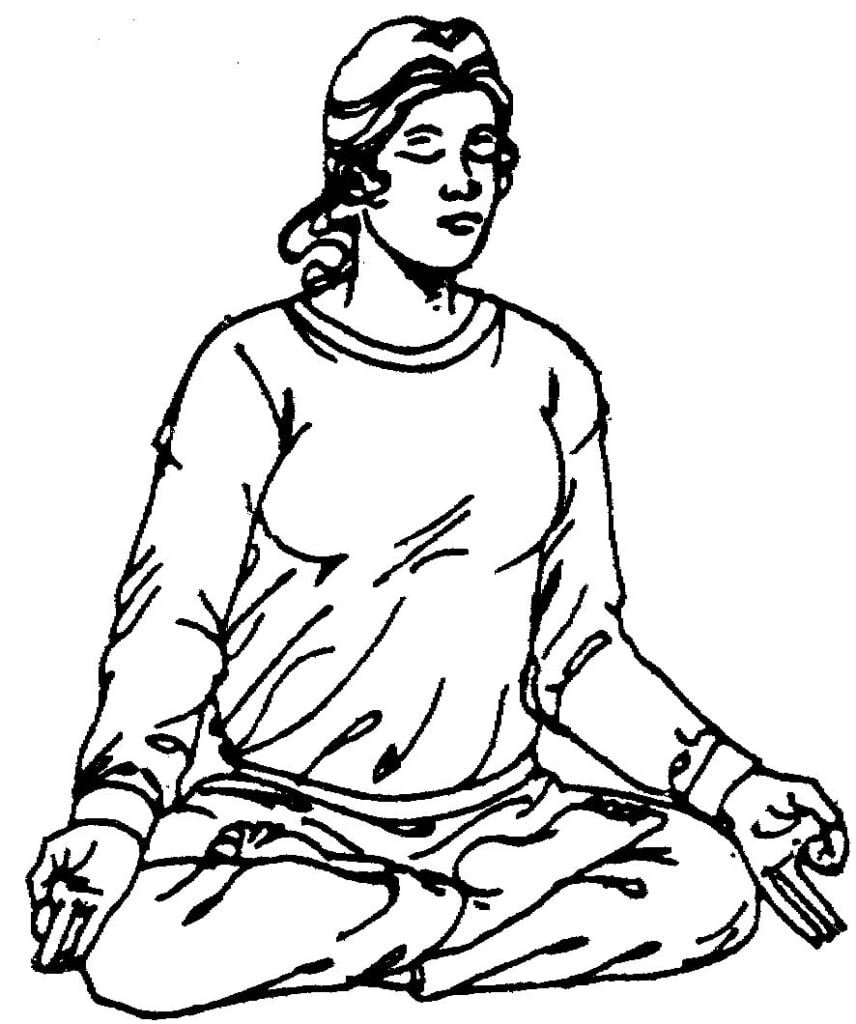
Sit on a blanket or a dari in Padma, Sidha or Sukhasana. Keep back, spinal cord and neck erect. Keep both the hands on knees. Shut your eyes. Sit peacefully. Exhale vigorously. Do not inhale. At start begin slowly after four to five exhales exhale vigorously and quickly. Be careful in exhaling; you will inhale between exhales.
One should not pause during the practice of Kapalbhati. Hold the breath after exhaling (Kumbhak). During Kumbhak practice Jallandhar Bandh, Uddiyana Bandh, Mool Bandha and Mahabandha. Hold this position for a while. Release all Bandhas and inhale slowly. This completes one round of Kapalbhati. Start with two rounds. You can practice unto five rounds gradually. Start with ten or twelve exhales. Gradually you can increase their number 50 to 120.
Special Note :
1. The stomach should go inside at once after exhaling.
2. The difference between Kapalbhati and Bhastrika Pranayama is that both inhale and exhale are done vigorously. One should learn it from an expert of Yoga.
Precautions : Persons with high BP problems or pus in the ear should refrain from doing this exercise.
Benefits : Kapalbhati is a very good invigorating exercise which cleanses the entire respiratory system by forcefully rushing exhalation.
It removes concentration and mental retention. The movement of the diaphragm stimulates the stomach, heart liver and spleen. This exercise is very good for eyes.
Agnisar
The practice of Agnisar kindles energy in stomach and body perspires.
Sit on a blanket or dari in Vajrasana. Keep a little distance between the knees. Put firmly both the hands on the knees. Inhale vigorously and while exhaling shrink your stomach as much as you can. Now suspend your breath. It is called outer (Bahya) Kumbhak.
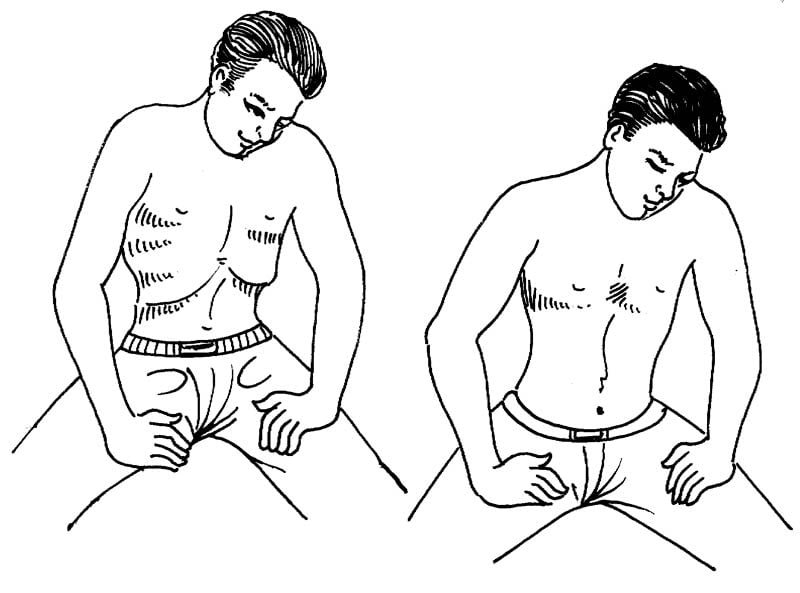
Holding the position of Bahya Kumbhak, i.e. keeping the breath suspended and pulling the entire abdominal region back towards your spine. Now blow your stomach out and shrink in. In one Kumbhak you can blow and shrink your stomach 8-20 times .
This kriya is called Agnisar. One can practice this kriya in a standing posture.
Benefits :
1. Cures obesity.
2. Cures disorders of abdominal region.
3. It improves lack of appetite.
Bandhas
Bandh means binding. Bandhs literally means a lock, bondage or joining together to objects or stages. A Bandh is a special posture invented to conserve and make greater use of vast resources of energy generated by yogic exercises and Pranayama. These Bandhs are means of reorientation and control of the vital energy of your body and mind. These are of three main types.
Jalandhar Bandha
It this Bandh the throat is contracted blocked, as it were, by making the chin rest on the chest in the notch between the collar bones. Once in a day early in the morning it should be practised, first standing, then in advanced stage in the sitting position.

Stand erect with your feet one foot apart. Bend the knees a little and then slightly bend forward. Rest your palms with fingers spread on your thigh above the knees. Take a few deep breaths and then exhale forcefully. This is automatically practised. In these postures the chin is firmly pressed against the chest. This chin lock regulates the flow of blood to the heart, head, brain and neck. Jalandhar Bandh is also practised in combination with Moola Bandh.
Uddiyana Bandha
It is a very powerful Bandh and a basic for regulating the flow of Prana and awakening of Kundalini. Uddiyana involves the lifting of the diaphragm high up the chest and pulling up the abdominal organs towards the spine. It means to fly up. This Bandh makes the great bird of Prana fly towards the highest chakra Bramharandhara or Sahasrara. Inhale upto fill and exhale so as to empty your lungs completely.
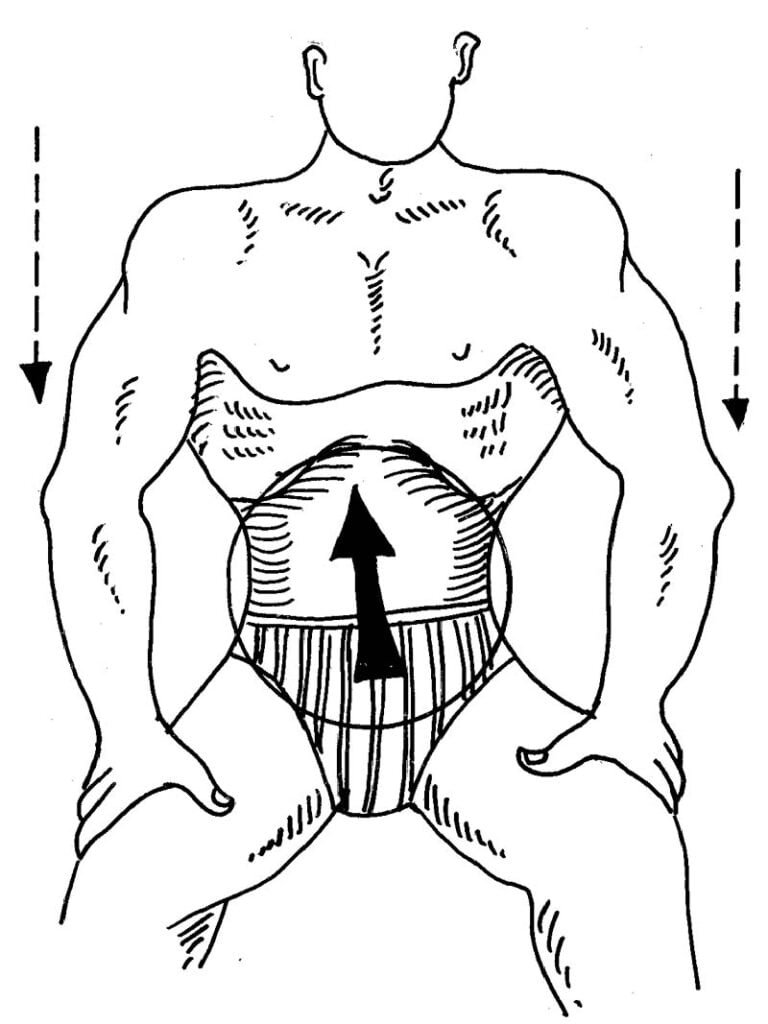
and stretch the abdomen inwards
Keep the breath suspended and pull the entire abdominal region back towards your spine. Then draw it up toward thorax. Keep the pressure of your palms on the thighs all this time. Remain in the pose for 20-30 seconds according to your capacity.
Relax the grip on your abdominal region and inhale slowly and deeply. Repeat the cycle three to five times.
Benefits :
1. Uddiyana Bandh is of great spiritual value as it forces the Prana upto Sushumna nadi.
2. It invigorates the whole abdominal region.
3. It is said to rejuvenate an old person, if it is properly and constantly practised.
4. The uplifting of diaphragm massages the heart muscles.
Moola Bandha
Moola literally means the root, source, foundation or the basis. In it the portion between anus and scrotum is contracted and raised. This prevents Apana escaping from the lower body and draws it up to unite with Prana.
Sit in Padmasana or Sidhasana. Stretch your hands and fingers as if in Gyan mudra. Now inhale deeply and retain your breath. Press the chin against the chest in the chin lock. Now contract the region of lower abdomen between the anus and the navel towards you spine and pull it upwards towards the diaphragm. The contract and pull towards the abdominal muscles and remain in the posture for a few seconds. Now release the grip on abdominal muscles and remove the chin lock. Exhale slowly and evenly. Repeat the cycle three to five times.
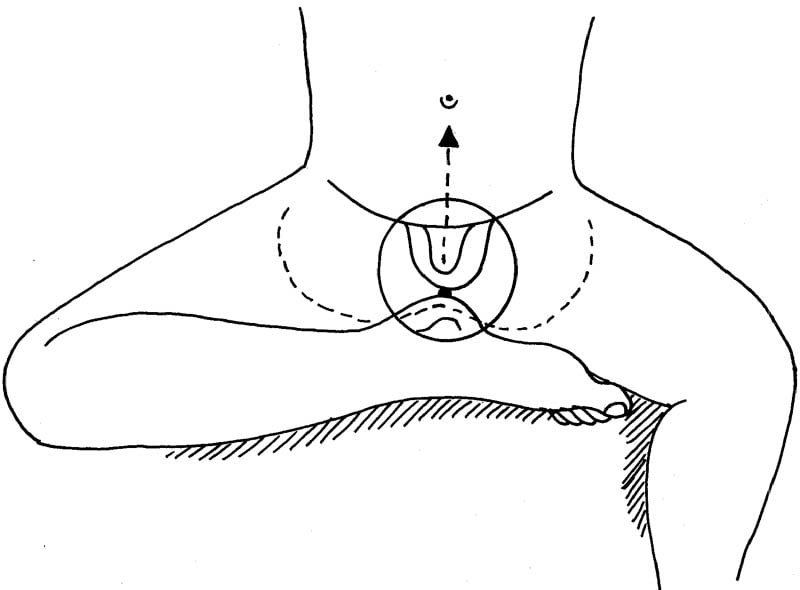
Benefits :
1. It cures piles.
2. It cures the disorders of intestines.
3. It prevents Apana vayu (foul wind) escaping from the lower body and draw it to unite with the Prana vayu (the vital wind).
4. It increases sexual retention power which we sublimated makes a man ‘Urdhvaretus’ or a person of great moral and spiritual power.
5. It also helps in awakening the dormant Kundalini.
The Moola Bandha should be practised when one becomes perfect in doing certain difficult asanas like Shirshasana. Sarvasana etc.
Maha Bandha
Sit in Padmasana on a blanket. Shut your eyes. Now practise Jalandhar, Uddiyana and Moola Bandha together.
Benefits :
1. You get the benefit of all the three Bandhs at once by Maha Bandha.
2. It cures the menstural problems of ladies.
3. It cures ovarian problems of ladies.
4. It helps in strengthening sex organs of males.

